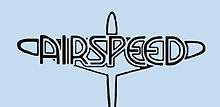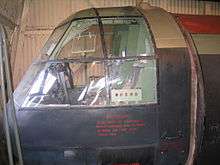Airspeed Ltd.
 | |
| Private Ltd | |
| Industry | Aeronautical engineering |
| Fate | Merged |
| Successor | de Havilland |
| Founded | 1931 |
| Defunct | 1951 |
| Headquarters |
Founded in York, England moved to Portsmouth, England. |
Key people |
A.H. Tiltman Nevil Shute Norway |
| Products | Aircraft |
Airspeed Limited was established to build aeroplanes in 1931 in York, England, by A. H. Tiltman and Nevil Shute Norway (the aeronautical engineer and novelist, who used his forenames as his pen-name). The other directors were A. E. Hewitt, Lord Grimthorpe and Alan Cobham. Amy Johnson was also one of the initial subscribers for shares.
Foundation
Airspeed Ltd. was founded by Nevil Shute Norway (later to become a novelist as Nevil Shute) and designer Hessell Tiltman. In his autobiography, Slide Rule: Autobiography of an Engineer, Norway gives an account of the founding of the company and of the processes that led to the development and mass production of the Oxford. He received the Fellowship of the Royal Aeronautical Society for his innovative fitting of a retractable undercarriage to the aircraft.
Early operations
After a short production run of the AS.1 Tern glider, Airspeed produced the AS.4 Ferry, a three-engined, ten-passenger biplane, concentrating on transport monoplanes thereafter. In March 1933, the firm moved to Portsmouth and, in the following year, became associated with the Tyneside ship builder Swan Hunter & Wigham Richardson Limited and became Airspeed (1934) Limited[1] in August 1934. During this period, it developed the AS.8 Viceroy for an intercontinental air race.
Wolseley engine
All Airspeed aeroplanes under manufacture or development in 1936 were to use a Wolseley radial aero engine of about 250 horsepower (190 kW) which was under development by Nuffield, the Wolseley Scorpio. The project was abandoned in September 1936 after the expenditure of about two hundred thousand pounds when Lord Nuffield got the fixed price I.T.P. (Intention to Proceed) contract papers (which would have required re-orientation of their offices with an army of chartered accountants) and decided to deal only with the War Office and the Admiralty, not the Air Ministry.
According to Nevil Shute Norway it was a very advanced engine (and the price struck Shute as low; much lower than competing engines on the basis of power-to-weight ratio), so its loss was a major disaster for Airspeed (and Britain). But when he asked Lord Nuffield to retain the engine, Nuffield said "I tell you, Norway ... I sent that I.T.P. thing back to them, and I told them they could put it where the monkey put the nuts!" Shute wrote that the loss of the Wolseley engine due to the over-cautious high civil servants of the Air Ministry was a great loss to Britain. Shute said that "admitting Air Ministry methods of doing business ... would be like introducing a maggot into an apple .. Better to stick to selling motor vehicles for cash to the War Office and the Admiralty who retained the normal methods of buying and selling."[2]
Second World War
In June, 1940, formal announcement was made that the de Havilland Aircraft Co., Ltd., had completed negotiations for the purchase from Swan, Hunter and Wigham Richardson, Ltd., of that firm's holding of Airspeed ordinary shares. Airspeed retained its identity as a separate company though as a wholly owned subsidiary of de Havilland.
Around 1943, presumably to reduce the risk of Luftwaffe bombing, a new dispersed design office was opened at Fairmile Manor in Cobham, Surrey; little is known of this establishment and nothing survives there today.
Airspeed's most productive period was during the Second World War. The graceful, twin-engined trainer-cum-light transport aircraft known as the AS.10 Oxford had a production run exceeding 8,500.
3,800 AS51 and AS58 Horsa military gliders were built for the Royal Air Force and its allies. Many of these made one-way journeys into occupied France as part of the D-Day landings, and later the Netherlands for the Arnhem landing, towed from England behind aircraft such as the Douglas Dakota and Handley Page Halifax.
Postwar operations

The company reverted to the company name of Airspeed Limited on 25 January 1944. Postwar it became involved in adapting some surplus ex-RAF Oxford aircraft as AS65 Consuls for the commercial market. Airspeed went on to produce the superbly streamlined pressurised twin-engined piston airliner called the AS57 Ambassador. This served successfully for some years with British European Airways as their "Elizabethan Class".[3]
In 1951 Airspeed Limited completely merged with de Havilland. The original York factory was demolished in November 2015.[4]
List of aircraft and first flight
- Airspeed Tern – (1931)[5]
- Glider (sailplane); built to get publicity by breaking British gliding records (Two built; plus parts for third, which were sold)
- AS4 Ferry – (5 April 1932)
- Three-engine biplane transport aircraft
- AS5 Courier – (1 April 1933)
- Single-engine low-wing monoplane passenger transport with retractable undercarriage of conventional configuration
- AS6 Envoy – (26 June 1934)
- Two-engine development of the Courier
- AS8 Viceroy – (August 1934)
- Variant of Envoy, adapted for long-range flight. One aircraft was built
- AS10 Oxford[6] – (19 June 1937)
- Larger two-engine development of Envoy
- AS16
- Projected license production of Fokker F.XXII, none built.
- AS20
- Projected license production of Fokker F.XXXVI, none built.
- AS30 Queen Wasp – (11 June 1937)
- Single-engine single-seat biplane target drone aircraft
- AS39 Fleet Shadower – (18 October 1940)
- Four-engine high-wing monoplane maritime patrol aircraft prototype. Two aircraft were ordered; one was completed
- AS45 Cambridge – (19 February 1941)
- Single-engine two-seater low-wing monoplane trainer aircraft with retractable undercarriage of conventional configuration. Two aircraft were built

- AS51 Horsa I – (12 September 1941)
- Large troop-carrying glider
- AS57 Ambassador – (10 July 1947)
- Two-engine high-wing piston engine airliner
- Variant of Horsa with openable nose section for front loading
- AS65 Consul – (March 1946)
- Civilian conversion of wartime Oxford
References
- ↑ http://www.flightglobal.com/pdfarchive/view/1934/1934%20-%200776.html
- ↑ Slide Rule by Nevil Shute (1954, William Heinemann, London) pages 234 – 237
- ↑ http://www.flightglobal.com/pdfarchive/view/1951/1951%20-%200357.html
- ↑ Bean, Dan. "Demolition well under way at Reynard's Garage in Piccadilly". Evening Press. Retrieved 24 November 2015.
- ↑ "Airspeed Type Designations". Flight International: 228. 23 February 1951.
- ↑ http://www.flightglobal.com/airspace/photos/civilaviation1903-1948cutaways/airspeed-oxford-cockpit-cutaway-8927.aspx
Further reading
| Wikimedia Commons has media related to Airspeed Ltd. |
- Nevil Shute Norway, Slide Rule (William Heinemann, London, 1954) Norway's biography covers his time at Airspeed in great detail
External links
- Airspeed Type Designations at Flight archive